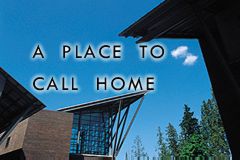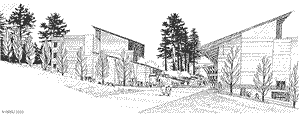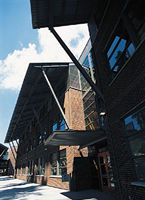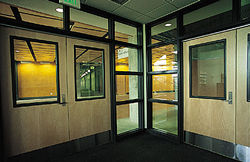
A Difficult Birth
That UW Bothell finally has a place to call home is the happy ending to a long saga. The problems with UWB's early years can be summed up with a real estate mantra: "location, location, location." When the state established five "branch campuses" in 1989 (two for the UW and three for WSU), it set four of them in established cities with a powerful business communities and vocal political support: Tacoma, Vancouver, the Tri-Cities and Spokane.
Then there was the fifth new campus—called UW Bothell/Woodinville—set down provisionally at the end of a business park off the Bothell-Everett Highway. There was no daily newspaper to champion the new campus, no business roundtable to drum up support, and not much interest among the local politicians. "It was clear to me when I took the job that many people right here in the area didn't know that UW Bothell existed," says UWB Dean Emeritus Norman Rose, who took over the institution four years after it opened.

After phase two is completed, UWB will have a second building, seen at the left of this architect's rendering. Sketch courtesy of NBBJ.
When the UW and WSU sold the Legislature on branch campuses, they told lawmakers there was a huge need for upper division and graduate-level courses. While the state's community colleges did a fine job offering freshman- and sophomore-level classes leading to an A.A. degree, there was a tremendous demand for upper-division courses. These new campuses would help satisfy this need.
But when UWB opened its doors in 1990, there were 143 students when the target was 400. "If there was this huge unmet need, then you'd expect people would be coming out of the woodwork to apply," grumbled State Sen. Dan McDonald, '65, '75.
During the 1991 legislative session, the head of the Senate Higher Education Committee did more than grumble. Sen. Jerry Saling introduced a bill that would have closed UW Bothell permanently. The bill never made it out of committee, but the threat did its damage. "Faculty morale was very, very bad," says Rose. "Prospective students wondered if there would be a campus to go to in the fall."

At the juncture of two slightly angled building volumes is the main entrance to the UWB building.
By the fall of 1992, enrollment grew to 439, but that was still 33 percent below that year's target. Then came another blow to UWB's stability. At his last press conference before leaving office, Gov. Booth Gardner, '58, proposed the creation of Cascade State University, turning UW Bothell into a four-year institution with its own board of trustees. The idea came as a complete surprise to lawmakers and the state's higher education planning agency.
While Gardner's plan had little political support, more damage was done. "Phone lines are flooded with calls from students asking if they will be able to complete their degrees, wondering about registration, or even withdrawing their applications for admission," then UW Provost Laurel Wilkening declared.
If Saling and Gardner are the "bad guys" in this saga, Rose is one of the heroes. A longtime UW chemistry professor, Rose had won a Distinguished Teaching Award and chaired the Faculty Senate before taking over UWB in 1994. Once on board, he tirelessly recruited new students and top faculty while trumpeting the strengths of his campus to any and all community groups.
He and other UW officials convinced the Legislature to add other degree programs to the original liberal studies B.A. By 1998 Bothell was offering degrees in nursing, business, education and computer software. "Bothell looked more like a multiple service university," Rose explains.

Blonde wood paneling is found in the main reception areas of the campus. Yellow plaster decorates the walls of UWB while blue plaster is the color for CCC.
Enrollment started growing by 14 percent each year. Instead of being the "branch" campus that missed its targets, it became the campus with the best enrollment record. "We moved from worst to first," Rose says. The dean emeritus says many others deserve credit for the turnaround. "The faculty and staff worked very hard," he says. UWB alumni were also crucial in spreading the word.
Today, even in its temporary quarters, UW Bothell is thriving, with more than 2,500 alumni and 49 faculty. While some students are returning adults who need to complete their college degrees, others are transfers from the community college system or even the Seattle campus. "Our students are so proud and happy to be at the UW Bothell campus," says Chancellor Buck. "Our class sizes are not huge. Our faculty are very, very good teachers. When students graduate, they tell me they got just as good an education here as anywhere else."
Go To: Page 1 | Page 2 | Page 3 | Page 4
- Sidebar: Bothell Bits
- Sidebar: UW Bothell Opening Special Events
- See also Editor's Column on "Closed Doors, Open Possibilities"
- Return to September 2000 Table of Contents
Home / Current Issue / Archives / Talk Back / Advertising / Columns FAQ / Alumni Website / Search